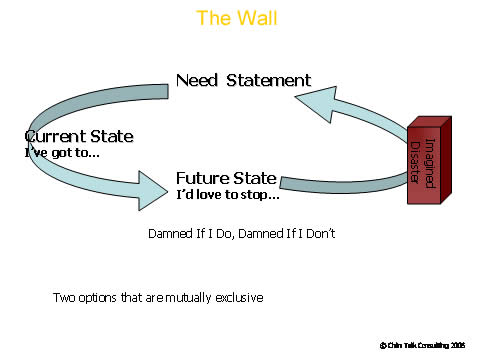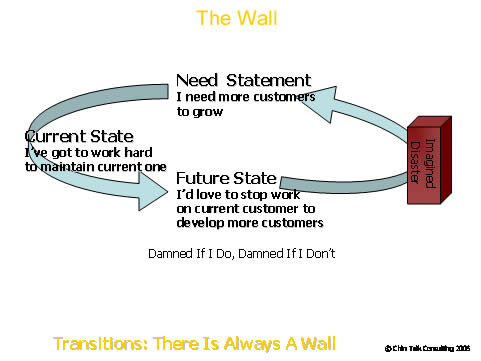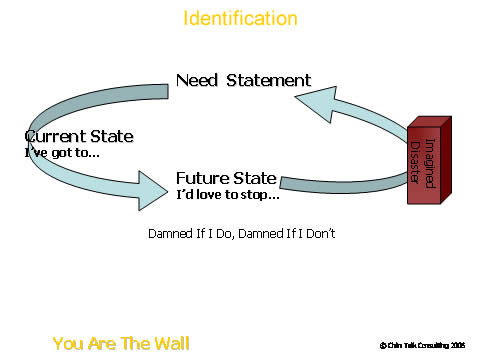 |
| Home | About Chin Teik Consulting Ltd. | Impact of Consulting | Products | Services | Association | Contact Us |
| |
| Damned If I Do Damned If I Don’t - Part I |
|
The Wall Let me begin by telling you a story. Once upon a time in the fairy land called ‘Making Money’ the emperor encouraged his people to start companies to make money. If his people can come up with a vision, some business sense and a product the emperor will fund the start up of the businesses. Soon, there were many small businesses in the ‘Making Money’ land. One day the emperor called his business people together and said that he would like the small businesses to expand to make more money. At that point, many of the business folks started to scratch their heads. They did not know what to do next? Many of these businesses were started within the family or mainly through one person. These businesses did not know what the next step is to expand their businesses. Does this tale sound familiar? The complexity, uncertainty, and interdependency increase by many folds for the entrepreneur himself/herself, the group and the organization when the business starts to grow. From a personal level, the entrepreneur will begin to deal with transitions on dependence, independence and interdependence level. The entrepreneur will have to make choices on how he or she spends his/her time – doing things that he or she deems as ‘got to do’ versus ‘love to stop doing or start doing’. The Growth Dilemma occurs when the entrepreneur mentally struggles between two opposing options that are mutually exclusive (‘have to’ versus ‘love to) and perceives a disaster of sorts if he/she chooses one over the other to meet a need. That perceived disaster leading to inertia is what I call ‘The Wall’. Transitioning from medium to big organizations will also face ‘The Wall’. Typical Examples Faced In The Growth Dilemma A) Growing The Business Need Statement: I Need To Grow More Customers. Current state: I have to maintain my key customers. Future State: I would love to stop taking care of my current customers and grow more customers. But if I do, then my current customer may not be happy, business may shrink and my revenue may go down. But if I don’t grow my customer base or do something different then I am subject to cost-price sensitivity of the current customers. If my main revenue comes solely from two customers, what will happen to me if they decide to cut me off their vendor of choice list?
B) Developing Successors Need Statement: I need to develop successors for my position. Current State: I have to run the business as there is no one but me. Future State: I would love to take some time off running the business to hire, develop and train Jin and James to become my successors. But if I were to take time off from running the business and do people development then who will run the business? But if I don’t I will get burned out just working these 15 hour days. What do I do? C) Shipping Quality Products Need Statement: We need to ship quality products. Current State: We are having bad quality products getting into customers’ doors. Our customers are not happy with us. Future State: We would love to stop shipping bad quality products. We would love to stop, step back and fix our bad quality products. But if we do that, our customers will be very unhappy with us for missing the shipment dead line. It is a vicious cycle and we do not know how to stop this cycle.
Identification Of The Wall Use the diagram and see if you can identify The Wall you and or your organization is facing?
If you and your organization are also going through a Growth Dilemma and you are interested to find out what you can do to Break Through The Wall, please read the second part of the Growth Dilemma series.
I would like to thank Brad Boyer of Boyer Communications and Bill Daniels from American Consulting & Training for helping me gain clarity around The Growth Dilemma. It was through hours of conversations with Brad and Bill separately that I got clearer with my company’s mission around Growth Dilemma. About The Author: Cheah Chin Teik is founder and President of Chin Teik Consulting Ltd., based in Hong Kong. Chin Teik is an experienced coach in organizational and leadership effectiveness for business results, scale-ability and sustainability via alignment and engagement of entire workforce. Chin Teik facilitates senior executive and/or executive teams to a clearer understanding of their leadership behavior while embedding a system of management practices to deliver business results. Renowned worldwide for his dynamic and intuitive consulting process, Chin Teik’s specialization areas are executive coaching and/or executive team coaching on strategic planning system and process, organization effectiveness, leadership and management development and system of management implementation. Chin Teik also specializes in enabling ‘HR and Training strategies for organizational impact’ and implementing ‘Continuous Improvement Process’. Chin Teik’s coaching and consulting efforts cut across a wide range of industries from Legal, Water Utility, Elevator, Oil & Gas, Advertising, Packaging, Precision Engineering and Semiconductor. A charismatic global leader, Chin Teik has amassed invaluable experience in manufacturing, training & development, total quality management and over 28 years of experience playing critical human resource roles in Intel on a regional and global scale. Chin Teik has to his credit the prestige of setting up the first-ever 10, 000 sq. ft. Intel University Training Center to deliver ‘Transformation of Workforce’ program to entire factory. Chin Teik also played an instrumental role in the founding of the Penang Skills Development Center. Chin Teik can be reached at chin.teik@chinteik.com. Copyright © 2007 Chin Teik Consulting Ltd
|
| Home | About Chin Teik Consulting Ltd. | Impact of Consulting | Products | Services | Association | Contact Us |


